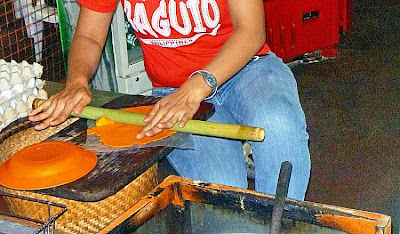 |
| Batac Riverside Empanadaan |
The Ilocos empanada (a local meat and vegetable-filled pastry), which comes in two varieties, is one of my favorite local snacks and I’ve tried the Vigan variety when I was in Ilocos Sur’s Heritage Village. Back in Batac City during the Lakbay Norte 2 media tour, this time I was going to try out the Batac variety, reputably the best empanada in the region. They are also a lot bigger than the regular empanadas sold in Metro Manila. The Ilocos empanada, similar to a taco but closed, is actually of Spanish and Mexican origin and the basic empanada has a galapong (rice flour) crust filled with grated green papaya, chopped longanisa (pork sausage) shredded carrots, fried egg and mongo bean sprouts (togue or balatong).
 |
| The dough is prepared |
The place to go for this delicacy is the Batac Riverside Empanadaan situated beside the Quiaoit River. Here, numerous food stalls sell, aside from empanada, Ilocano dishes as well as street food such as longanisa and isaw which locals curiously dip in ketchup rather than vinegar. Unlike the colorless, crunchier and thin-crusted Vigan empanada, the crust (pinais) of the Batac empanada is a bright golden orange color because of the annatto or atsuwete (or achuete), thicker and is less crispy. The Batac empanada uses the entire egg while in the Vigan variety, the egg white is removed (the egg white was an important building material at that time).
 |
| An egg is added |
The Batac empanada also uses the saltier Laoag longanisa while the Vigan variety uses the vinegar-seasoned, small, plump and garlicky Vigan longanisa. Many Vigan empanadas also do not have the mongo bean sprouts, just the grated green papaya, and are wrapped in banana leaves. The vinegar (sukang iloko) dip used also accentuates the differences between the two varieties. The very strong Vigan vinegar has an alcohol-like fermented taste while the sour Laoag vinegar usually has bird’s eye chili (siling labuyo) added to it.
 |
| The finished product. Yummmm!!!! |
At our selected stall, we had a choice of having just an ordinary empanada with just the grated papaya, mongo bean sprouts and egg (PhP30); the ordinary eggless empanada with just the vegetables; the special empanada with longanisa and egg (PhP35); the special eggless empanada with longanisa but no egg; the special empanada with everything minus the mongo bean sprouts; the jumbo empanada with hot dog (PhP50); the double special empanada with two longanisas and one egg; the double egg empanada with one longanisa and two eggs; and the double double empanada with two longanisas and two eggs. Estan Cabigan and I chose the last, the heaviest of them all, which we shared. The cook first lays huge amounts of the abovementioned ingredients inside the orange dough, seals it and then deep fries it.






.jpg)
.jpg)
